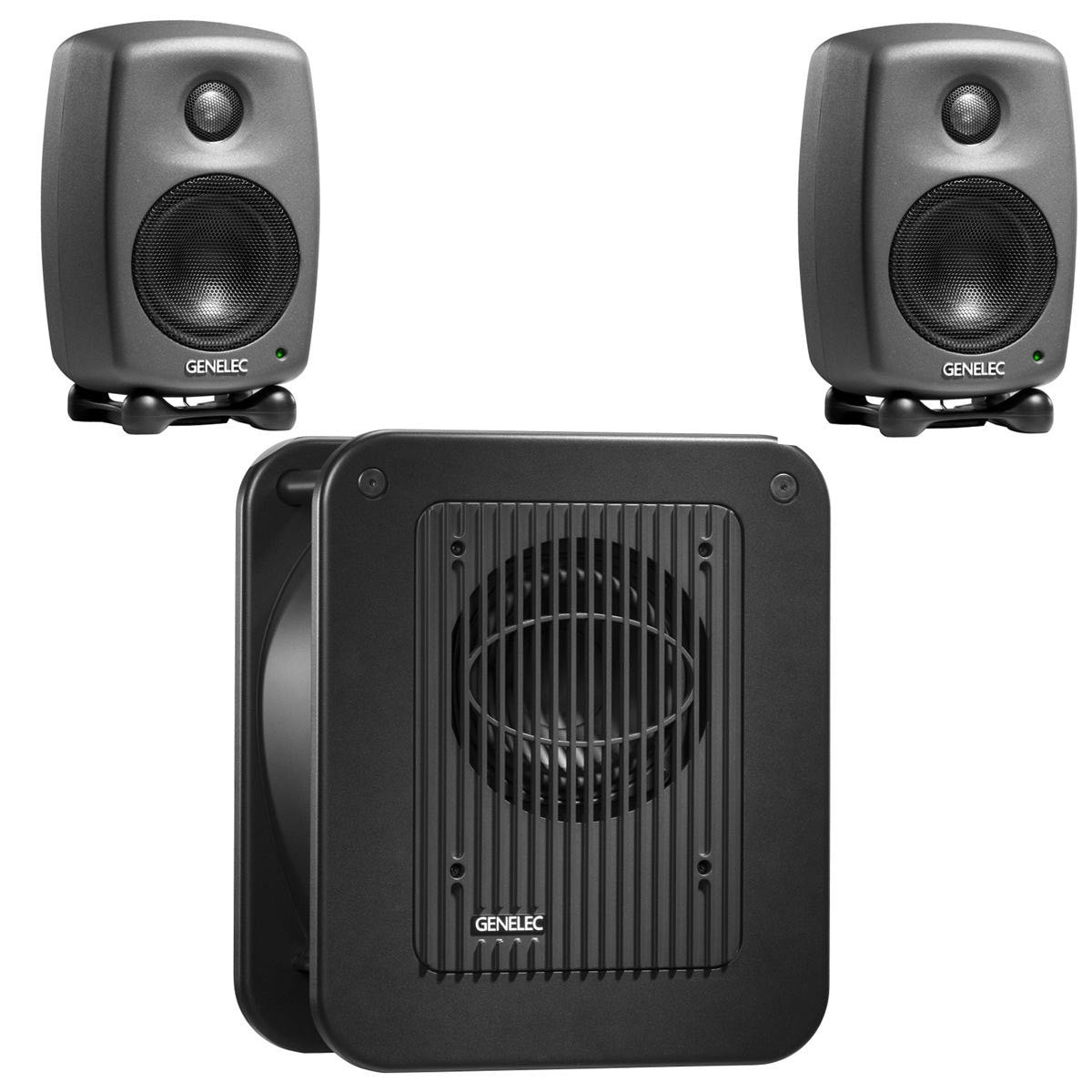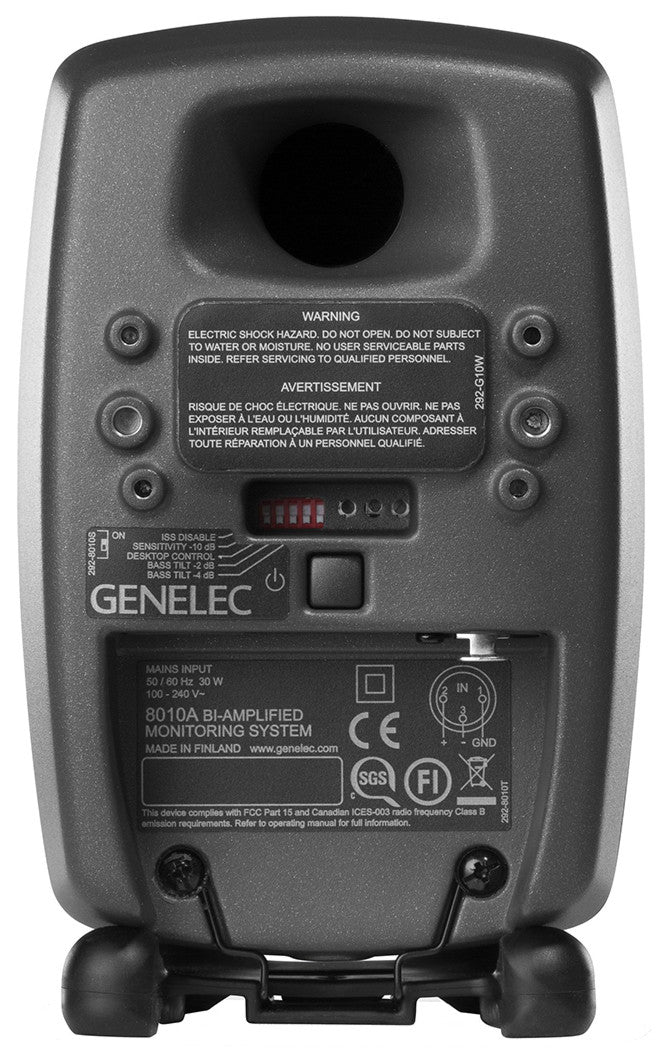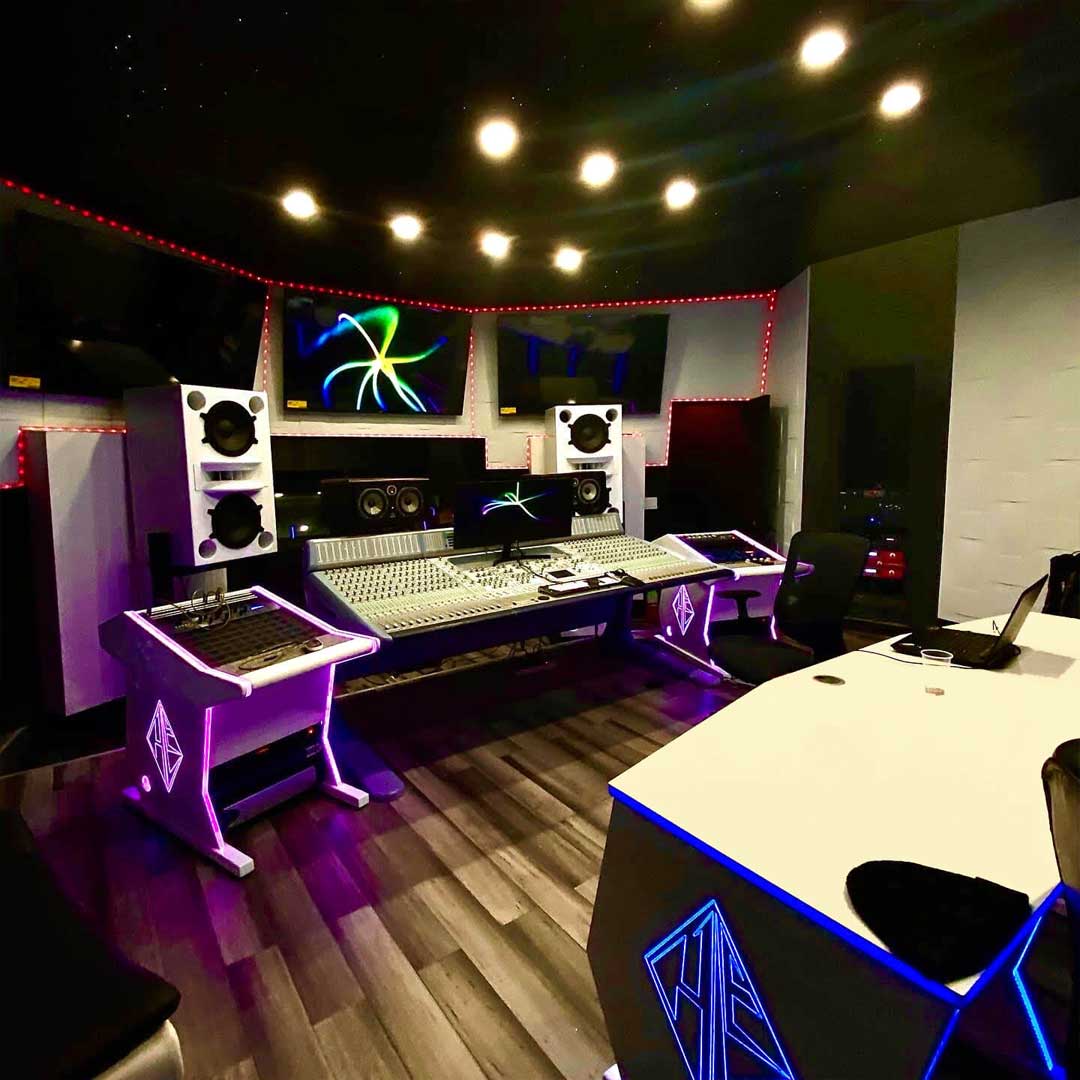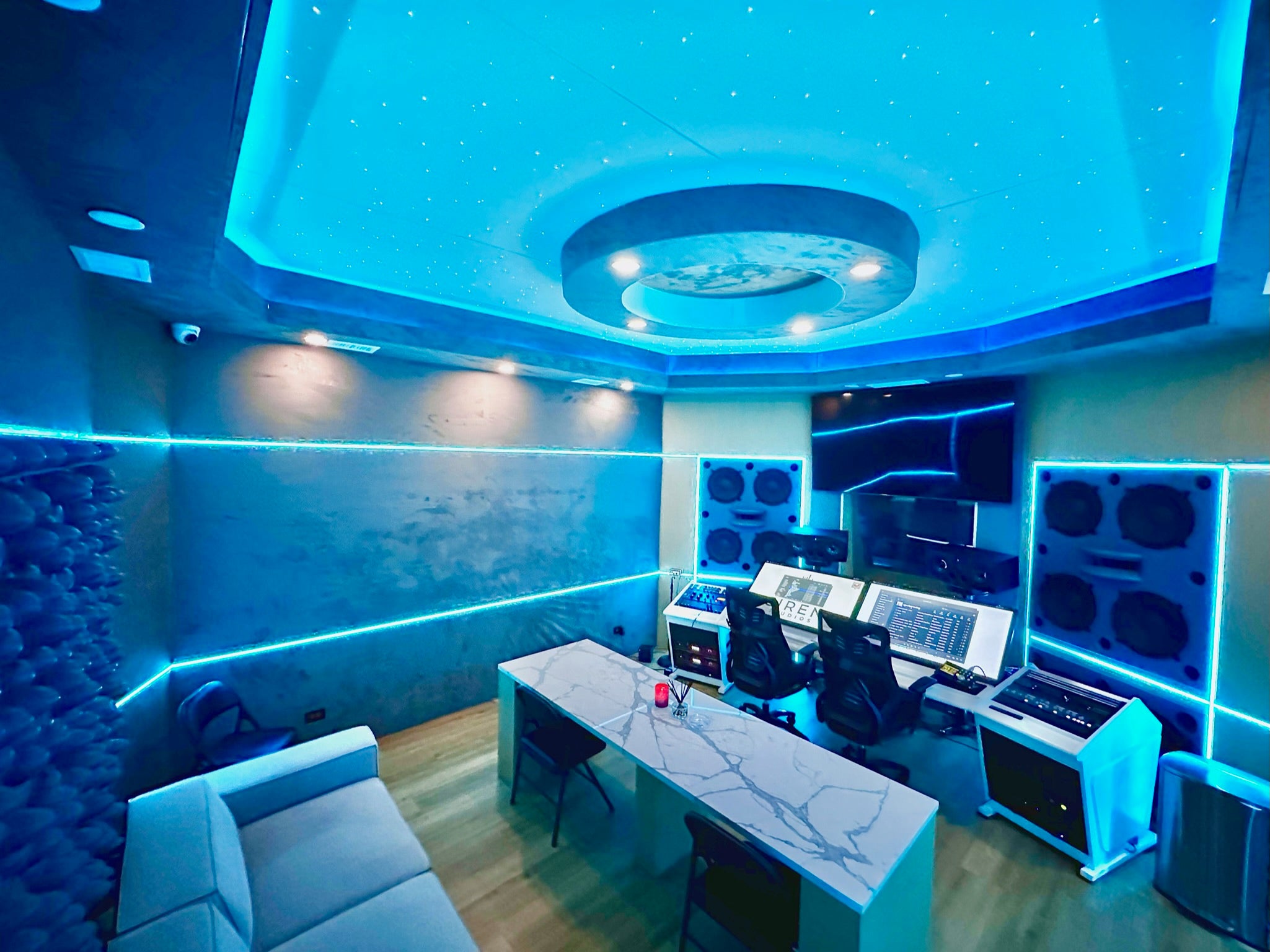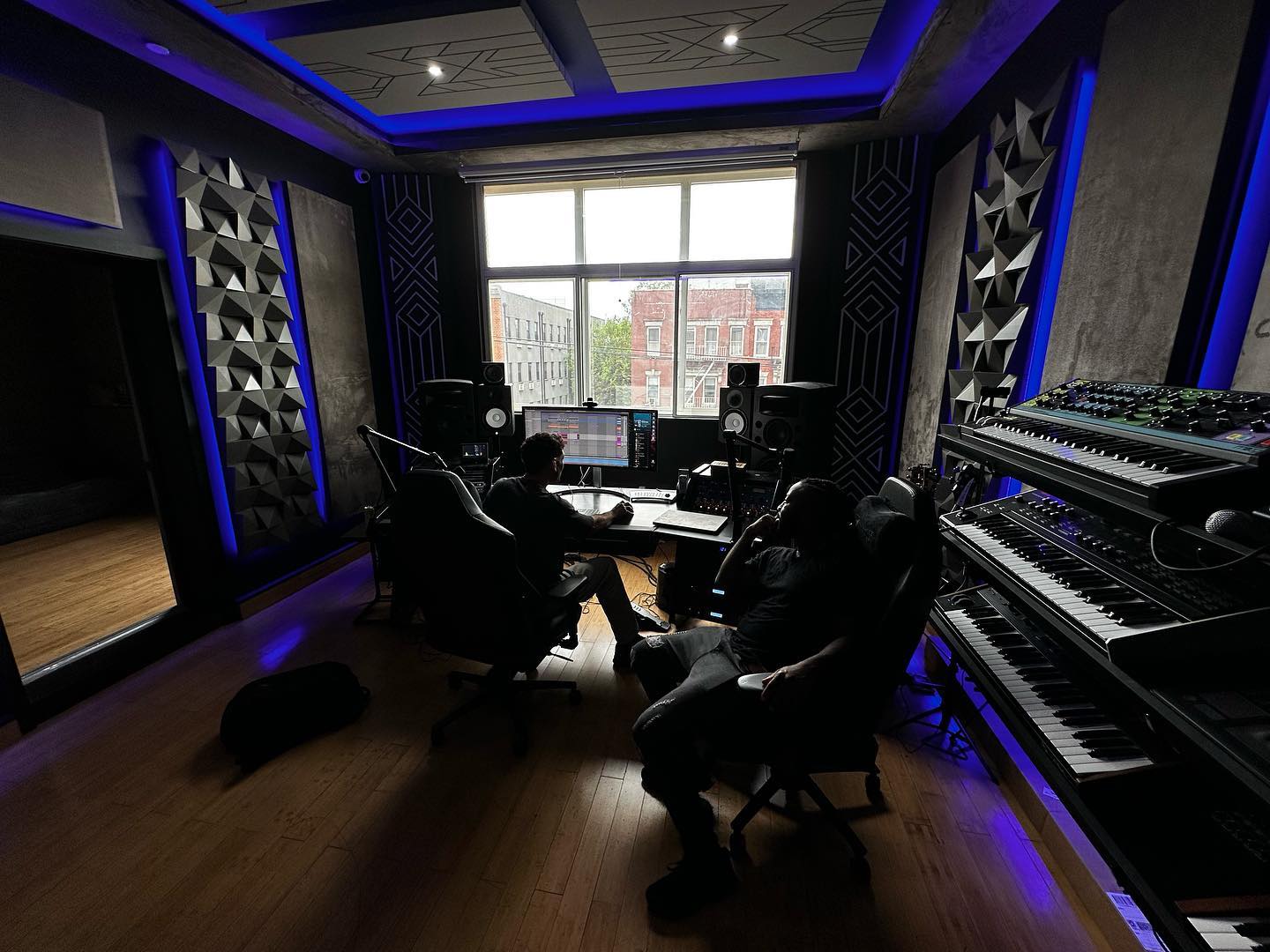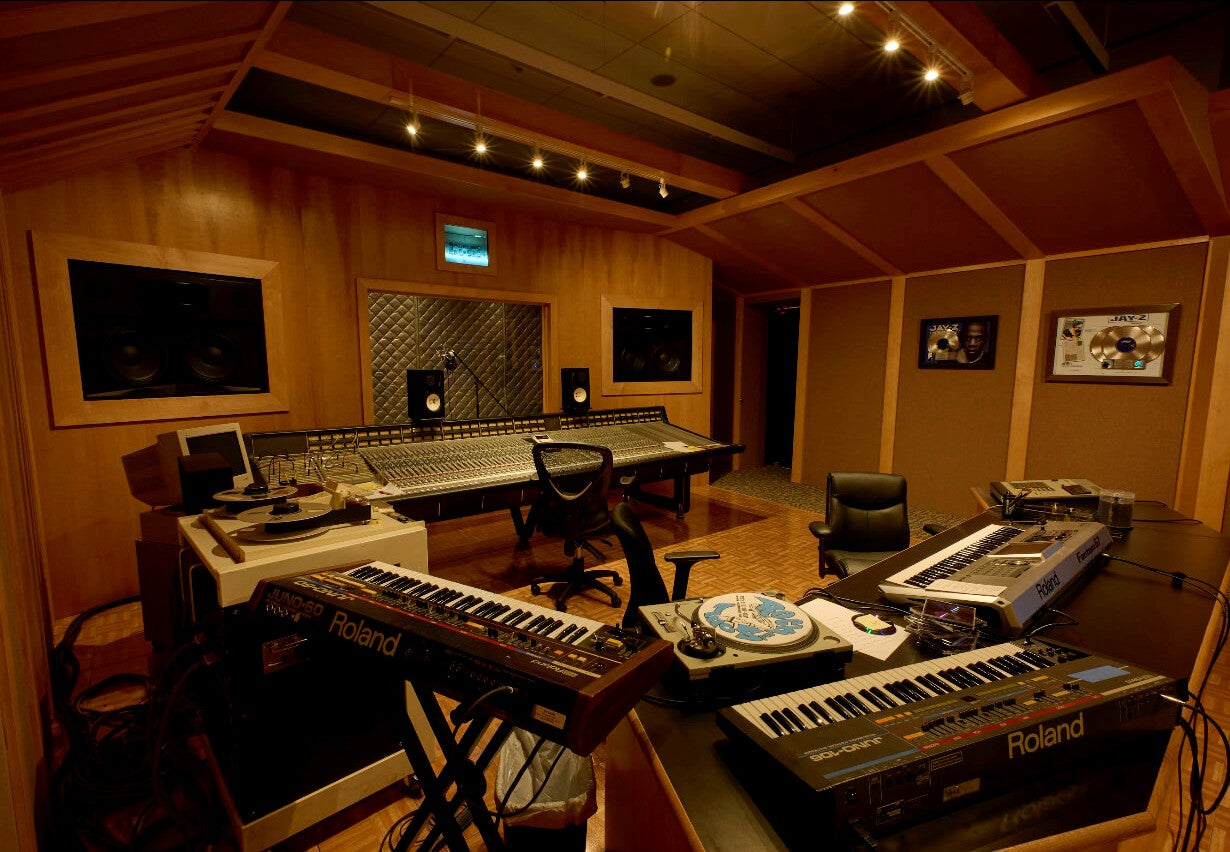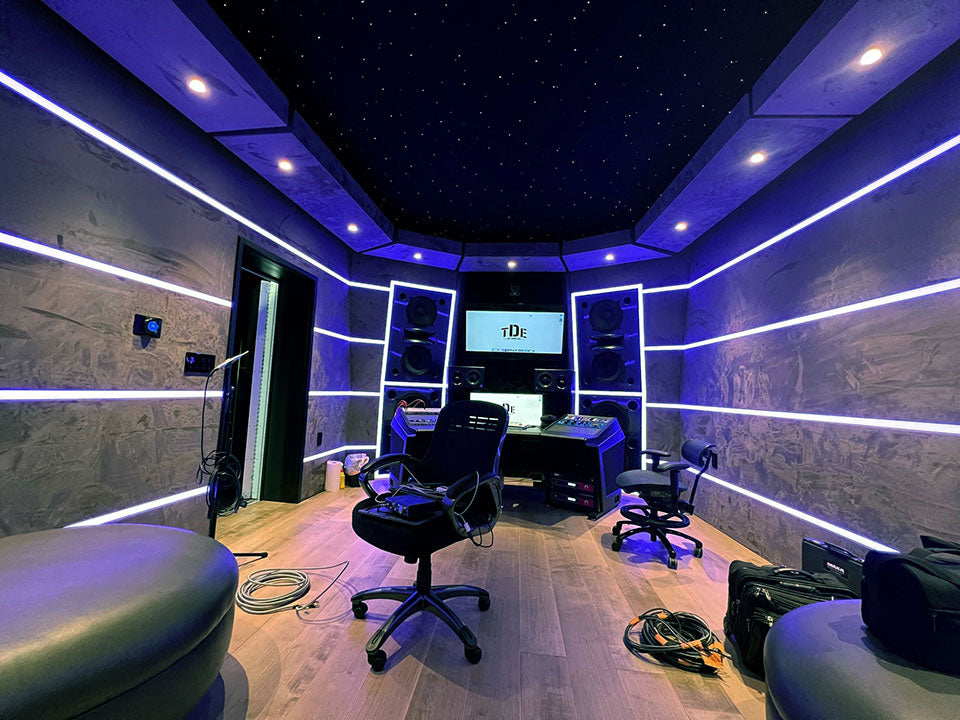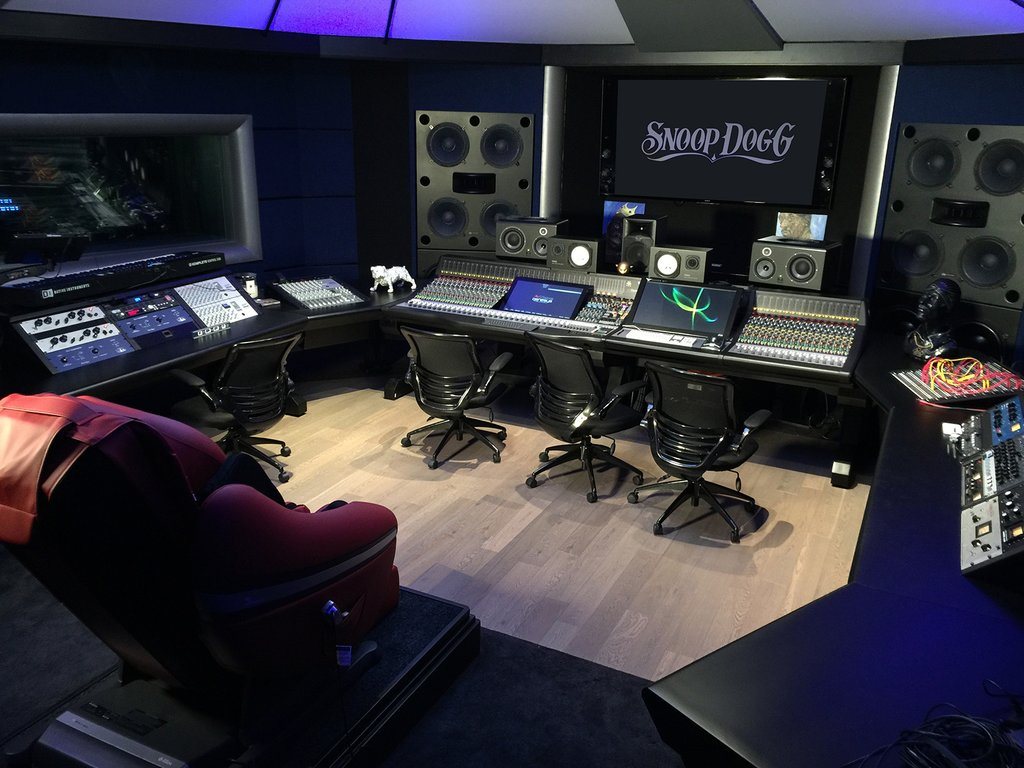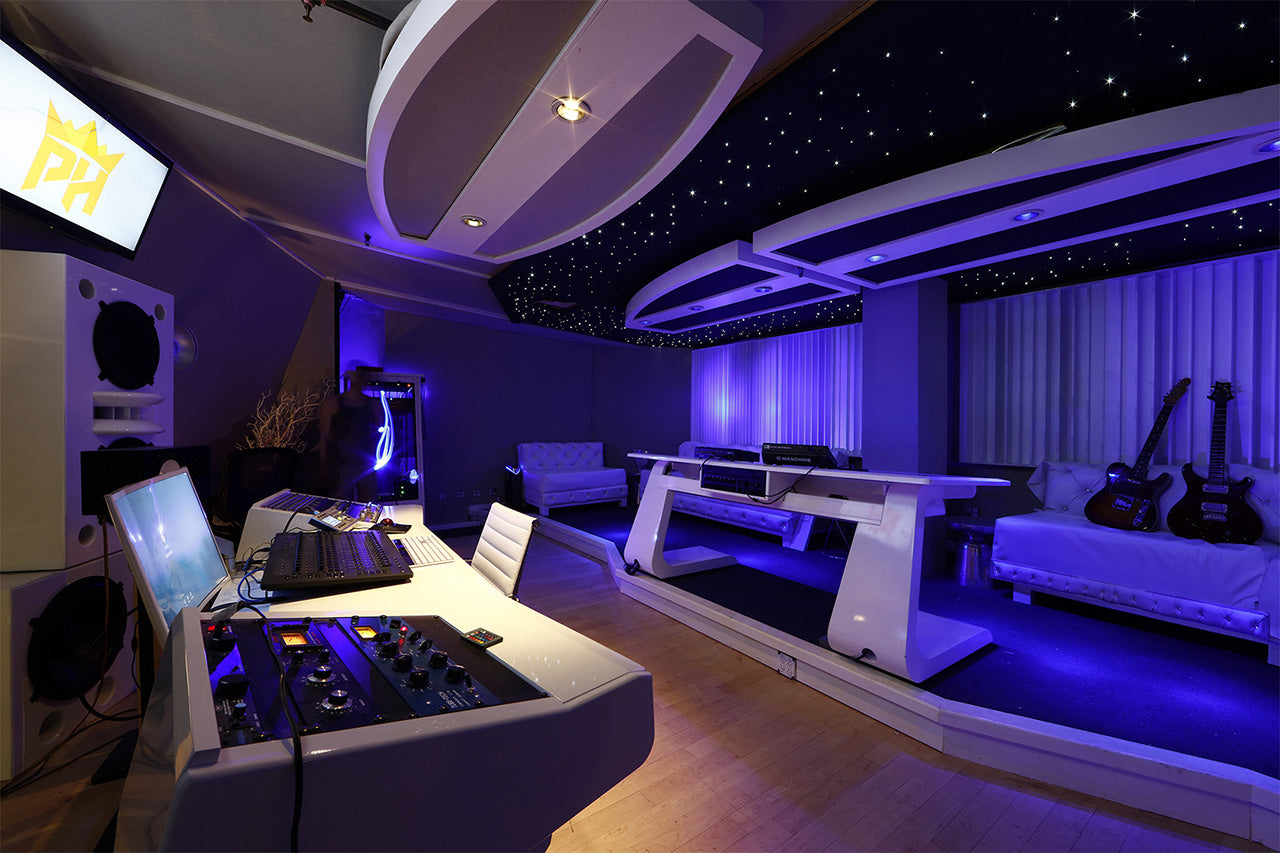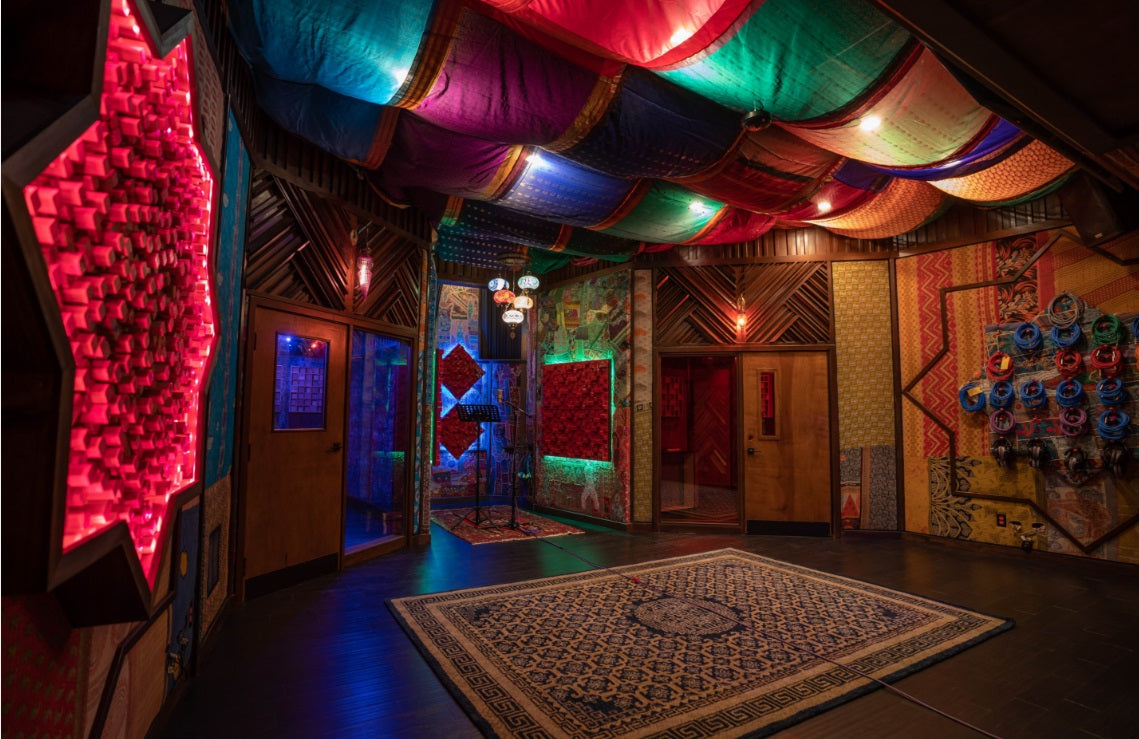Genelec 8010.LSE StereoPak
The Genelec 8010.LSE Stereo Pak is a no-compromise, 2.1 system designed for the desktop producer, small edit suites, or mobile rigs with a stereo pair of 3" Genelec 8010C monitors and 6.5" 7040A subwoofer.
Who says you can't take it with you? These days, it's not uncommon for people to produce professional quality music with nothing more than a laptop and a portable interface in the corner of a bedroom studio or on the go. For the desktop producer who may have to compromise on space but won't accept compromise on sound quality, Genelec offers the 8010.LSE StereoPak - a high-quality ultra-compact system that gives you studio-quality sound and a full-range sound despite its diminutive size. The 8010.LSE StereoPak is also a great option for high-quality audio playback of online streaming music and music video. All it takes is a simple RCA to XLR adapter, since the 8010A can handle an unbalanced signal. The StereoPak includes two Genelec 8010A bi-amped monitors and one 7040A subwoofer - all of which feature Genelec's most advanced sound reproduction technologies.
Genelec 8010.LSE StereoPak includes:
- Two 3-1/2", 50-watt (25W LF/25W HF) 8010A bi-amped active monitors
- One 6.5" 7040A ultra-compact subwoofer
Genelec 8010A bi-amplified active monitor
Small in stature big huge in spirit, the Genelec 8010A is designed to suit the broadest possible range of listening environments. It comes into its own where space is the final frontier, and draws on the Genelec's 8000-series innovations for an uncompromising nearfield experience. The proprietary Minimum Diffraction Enclosure (MDE™) gives you sound uncolored by cabinet reflections, while its wide sweet spot is a result of the precise on- and off-axis frequency reproduction of the Directivity Control Waveguide (DCW™). And when you find yourself napping or crashed out after a long session, having forgotten to power down, Genelec Intelligent Signal Sensing (ISS™) circuitry detects when your system is no longer in use, placing it into an environmentally friendly, power-saving standby mode. From post-production studios to OB vans and DAW-based rooms, the 8010A has been crafted to combine exceptional power with absolute precision for use in professional and home studios, edit suites, broadcast vehicles, or surround systems.
Genelec 8010A key features:
- Directivity Control Waveguide (DCW) technology for accurate on- and off-axis response
- Minimum Diffraction Enclosure (MDE) eliminates unwanted cabinet reflections
- Quiet reflex port design with high air flow
- Room-response EQ compensation
- Highly efficient class D amplifiers optimized for Genelec drivers
- Active crossovers
- Driver-protection circuitry
- Intelligent Signal Sensing (ISS) power-saving technology
- Iso-Pod decoupling and speaker orientation stand
- Versatile mounting options
Genelec 7040A PM Compact Subwoofer
The Genelec 7040A is an ultra-compact subwoofer designed for small spaces or mobile use with 6.5" driver, 50-watt Class D amplifier that outputs 100dB SPL, and low-frequency extension down to 30Hz.
While it is impossible to violate the laws of physics with no consequences, Genelec has proven with the ultra-compact 6.5" 7040A subwoofer that you can bend them a considerable amount, and all to your advantage - particularly if you're working with small monitors, limited space, or wish to travel with your 7040A in tow. Universal mains input voltage enables the globe-trotting engineer to use the 7040A anywhere in the world. (There's even an optional carry bag.) The 7040A's remarkable bass extension down to 30Hz enables you to make intelligent mix decisions in the nether regions of your mix, particularly when working with small monitors, such as the Genelec 8010, 8020, or M030, for which it is a perfect match. The 7040A owes its deep, controlled bass to Genelec's proprietary monitor technologies, including the Laminar Spiral Enclosure (LSE) and custom-designed Class D amplifier.
Genelec 7040A subwoofer key features:
- Compact enclosure with optimized design allows for accurate sound reproduction in small environments
- Laminar Spiral Enclosure (LSE) design provides extended low-frequency performance
- Genelec-designed Class D amplifier technology provides high SPL with very low distortion
- Universal mains input voltage allows easy world-wide connectivity to mains power
- Phase-matching and Bass Roll-Off control enable calibration to all acoustic spaces
- Power consumption savings thanks to Genelec Intelligent Signal Sensing (ISS™) circuitry which switches the subwoofer to standby when no audio input is detected
- Sustainability and green values, minimalistic industrial design for efficient enclosure footprint
- Two balanced XLR inputs and outputs enable easy connectivity to Genelec 8010, 8020, and M030 active monitors
- Genelec quality and reliability ensure a long-term security of investment, low energy consumption, and outstanding audio quality
PAD tech note: The letter “A” at the end of Genelec model numbers refers to the latest revision. “P” denotes the finish; Producer dark grey, while “M” designates magnetic shielding.
Genelec Proprietary Technologies - Under the Hood
Directivity Control Waveguide (DCW) Technology (8010A)
Genelec's Directivity Control Waveguide shapes the emitted wavefront of direct radiating multi-way monitors in a way that allows predictable tailoring of the speaker's dispersion pattern. DCW technology also minimizes early reflections, providing a wide, controlled listening area with accurate sound reproduction both on- and off-axis.
Another advantage of minimized early reflections and controlled constant directivity is that the frequency balance of the room's reverberation field is essentially the same as the direct field from the monitors. As a result, the monitor's performance is less affected by room acoustic characteristics.
The consistent off-axis frequency response of the waveguide enables engineers to move in and out of the sweet spot without losing perspective while working room.
DCW technology key benefits:
- Flat on- and off-axis response for wider usable listening area
- Increased direct-to-reflected sound ratio for reduced control room coloration
- Improved stereo and soundstage imaging
- Increased drive unit sensitivity up to 6dB
- Increased system maximum sound pressure level capacity
- Decreased drive unit distortion
- Reduced cabinet edge diffraction
- Reduced complete system distortion
Minimum Diffraction Enclosure (MDE™) Technology (8010A)
Genelec's highly innovative aluminum enclosure (MDE) improves the linearity of the frequency range and power response of free-standing monitors via rounded edges and gently curved front and sides optimized to match the acoustic properties of the drivers. In addition to achieving a remarkably flat frequency response, minimizing cabinet diffraction yields superb sound stage imaging.
Directivity is further improved by the waveguide being integrated into the MDE enclosure. Since the low-frequency limit for constant directivity is determined by the size of the waveguide, the larger the surface the better the control. Highly directional off-axis radiation yields a consistent listening window, which is critically important in multichannel monitoring. Controlled directivity also reduces possible first-order reflections on surfaces near the loudspeaker, such as walls, floors, ceilings, and studio furniture, which contributes to consistent audio reproduction in various acoustical environments.
High air-flow bass reflex port design (8010A)
There are three methods to handle bass frequencies in small monitors, infinite baffle, or sealed cabinet, ported reflex, and transmission line (passive radiator designs are a subset of ported reflex speakers). Genelec's choice for vented, or reflex, enclosures dates back to the first Genelec product in 1978. Since then Genelec has refined and improved their designs to increase low-frequency extension and sound pressure level capability to provide outstanding bass articulation and definition.
The downside of ported designs is that turbulence in the ports due to extreme air pressure from the driver excursions can cause chuffing noise in the ports, and/or interfere with frequencies higher up in the spectrum. To minimize air speed and turbulence, the cross-sectional area of the vent should be large. This, in turn, means that the vent tube has to be long, which presents quite a design challenge. Genelec's solution is a long, curved tube that maximizes airflow so deep bass can be reproduced without compression. The reflex tube terminates with a wide flare located on the rear of the enclosure minimizing port noise and providing excellent bass articulation.
The curvature of the tube has also been carefully designed to minimize any audible noise, compression, or distortion. The inner end of the tube has proper resistive termination to minimize audible chuffing noise and air turbulence. Proper reflex port design allows also to significantly reduce the woofer's displacement, improving the linear low-frequency output capacity.
PAD Pro tech note: For small cabinets to handle bass frequencies lower than the laws of physics would allow, the ported or reflex is the easiest design from a manufacturing standpoint to achieve a deep bass response. It takes advantage of the cabinet's resonance and in essence feeds sound coming from the rear of the speaker through a tube connected to the back of the cabinet into ports, which are usually on the front panel. The length and diameter of the tube are precisely calculated for the desired low-frequency response. The trick is to make sure the sound coming from the port is in phase with the speaker, which reinforces the low frequencies of the monitor. It's important to note that while this technique does provide a better bass response in small cabinets, it's primarily a psychoacoustic effect. The addition of a subwoofer enables smaller drivers to handle midrange frequencies while bass frequencies are directed to a larger dedicated bass driver.
Intelligent Signal Sensing function (8010A)
Genelec's Intelligent Signal Sensing (ISS) is a power-saving feature that prolongs the service life of the monitor. ISS reduces power consumption to less than 0.5 watts by automatically switching the active monitor to standby when no audio signal has been detected for some time. When playback begins, the mode indicator light on the loudspeaker lights up and the playback resumes after a slight delay (<2 seconds).
Protection circuitry (8010A)
The protection circuitry prevents driver failure by detecting signal levels and responding accordingly. In the case of sudden peaks or levels that are too high for long periods, the protection circuitry reduces signal level automatically. This feature does not affect the sound quality in any way when working within the specifications of the loudspeaker, but only prevents inappropriate input signals from breaking the loudspeaker.
Protection circuitry features and benefits:
- Reduces the output level when required (e.g. when driver voice coil temperature reaches the safe limit), which highly improves system reliability
- Appropriate protection circuitry design for each loudspeaker and subwoofer maximizes system output level
Room compensation controls (8010A)
Each room changes the monitor's response in a unique way, e.g. reflective vs. damped rooms, or placement against a wall vs. on a stand away from the walls. All Genelec loudspeaker systems feature room response adjustments to compensate for the room influences and retrieve a flat frequency response at the listening position. Frequency response can be adjusted to match the acoustic environment by setting the tone control switches on the rear panel of all Genelec monitors.
Optimized amplifiers with active crossover (8010A)
In a typical 2-way loudspeaker system, the active crossover needs two power amplifiers; one for the woofer and one for the tweeter. Electronic crossovers split the audio signal into separate frequency bands that can be separately routed to individual power amplifiers optimized for the frequency band of their respective transducers.
The power amplifiers are connected directly to the drivers of an active loudspeaker, resulting in the power amplifier's load becoming much simpler. Each driver-specific power amplifier has only a limited frequency range to amplify (the power amplifier is placed after the active crossover), which adds to the ease of design.
The active design principle offers multiple benefits:
- The power amplifiers are directly connected to the speaker drivers, maximizing the control exerted by the power amplifier's damping on the driver's voice coil, reducing the consequences of dynamic changes in the driver electrical characteristics. This may improve the transient response of the system
- There is a reduction in the power amplifier output requirement. With no energy lost in the passive crossover filter components, the amplifier power output requirements are reduced considerably (by up to 1/2 in some cases) without any reduction in the acoustic power output of the loudspeaker system. This can reduce costs and increase audio quality and system reliability
- No loss between amplifier and driver units results in maximum acoustic efficiency
- Active technology can achieve superior sound output vs. size vs. low-frequency cut-off performance
- All loudspeakers are delivered as a factory aligned system (amplifiers, crossover electronics, and enclosure-driver systems)
Iso-Pod stand (8010A)
Often workstation furniture has equipment racks whose top surfaces double as speaker stands. While this may be a convenient option, placing speakers on wooden surfaces or console meter bridges has side effects detrimental to accurate and effective monitoring. In such a scenario, aiming the loudspeaker axis towards the listener rarely occurs, and sympathetic vibrations (which are not very sympathetic to bass) propagate from the loudspeaker to the surface. Also, first-order reflections on the surface cause comb filtering and subsequently ripples in the frequency response.
To solve these very common problems, Genelec designed the Iso-Pod Isolation Positioner/De-coupler. Made from special lossy rubber-like material to de-couple the speaker from a surface, it has four shallow feet and is firmly attached to the enclosure so that it can be slid along the curved bottom or side surface to allow for a ±15° tilt of the loudspeaker. The loudspeaker's acoustical axis can then be pointed precisely towards the listener. The vibration isolation and damping properties reduce midrange coloration caused by unwanted vibration transmitted to supporting surfaces.
Versatile mounting options (8010A)
On the base of the 8010 is a 3/8" UNC threaded hole which can accommodate a standard microphone stand. On the rear there are two M6x10 mm threaded holes for an Omni-mount® size 20.5 bracket.
Laminar Spiral Enclosure (7040A)
An essential property of a subwoofer operating at high sound pressure levels is its capacity to move high volumes of air without distortion, which is a function of air turbulence inside the bass reflex port. This effect presents challenges to woofer and reflex port designs. Genelec's patented Laminar Spiral Enclosure (LSE) provided the solution.
By way of a little background, large air currents, such as those found in bass reflex ports, have a great deal of kinetic energy, which causes the flow to be irregular and turbulent as cross-streams perpendicular to the direction of air flow is formed. A laminar air flow is a streamline flow in which air travels smoothly in parallel layers or paths, with no interference or disruption across layers.
The Laminar Spiral Enclosure (LSE) bass reflex cabinet provides excellent laminar flow characteristics with minimal turbulence noise and enables an optimal packing of a very long reflex tube into a small space.
The 7040A's enclosure is made from a spiral-shaped strip of steel. Its purpose is to provide mechanical stability for a large amount of pressure generated inside the subwoofer. The spiral also forms the bass reflex port, enabling linear airflow even at the highest SPL output. The fact that one is part of the other means that air flow in and out of the enclosure's interior through the port is totally unrestricted. This flow-optimized construction provides extended low-frequency capacity and low distortion resulting in precise bass articulation, with measured second and third harmonic distortion levels typically better than 30dB below the fundamental. This results in an extraordinarily accurate and responsive low-frequency system.
Bass management system (7040A)
Bass management, from a corporate perspective, is the man's way of keeping the low frequencies down. Seriously, it's quite simply a means of directing the bass content of main and low-frequency effect (LFE) channels to the speakers that are best capable of handling them. A Bass Management system uses either analog electronic circuitry or software-based filtering to take low-frequency information from the main channels and route it to a subwoofer feed. Bass management's basic and main goal is to ensure that the entire audio bandwidth of all channels can be accurately monitored.
The bass management unit in the 7040A subwoofer splits the input into low- and high-frequency components at 85Hz. Frequencies below 85Hz are reproduced by the subwoofer. Frequencies above 85Hz are directed via the subwoofer's output connectors to the main monitors.
Bass management benefits are:
- The subwoofer extends the system frequency response down the lower limit of the audible range
- Monitor can produce a higher maximum sound level when not reproducing low frequencies
- Optimized low-frequency reproduction by selecting adequate subwoofer location; monitors can also be placed more freely
- Subwoofer's output are aligned in level and phase with monitors allowing flat and accurate reproduction down to 19 Hz and across the crossover point
- LFE channel output level (0 or +10 dB re. main channels) can be selected for accurate reproduction depending on the source type
- The ability to bypass the subwoofer allows you to evaluate the audible impact of the subwoofer
Don't think that a small space means you can't have a big sound. Order a Genelec 8010.LSE StereoPak and prove it to yourself. For more information, call or chat online with your PAD Studio Specialist.
Specifications
- Lower cut-off frequency, ”“6dB: ≤ 67Hz
- Upper cut-off frequency, ”“6dB: ≥ 25kHz
- Accuracy of frequency response: 74Hz ”“ 20kHz (± 2.5dB)
- Maximum short term sine wave acoustic output on axis in half space, averaged from 100Hz to 3kHz: @ 1 m > 96dB SPL; at 0.5 m: 102dB SPL
- Maximum long term RMS acoustic output in same
- conditions with IEC weighted noise (limited by driver unit protection circuit): @ 1 m > 91dB
- Maximum peak acoustic output per pair @ 1 m distance with music material: >105dB
- Self generated noise level in free field @ 1 m on axis: ≤ 5dB (A-weighted)
- Harmonic distortion at 80dB SPL @ 1 m on axis: Freq: 70-400Hz < 3%; >400Hz < 0.5%
- Bass driver: 3" (76 mm) cone
- Treble: 3/4" (19 mm) metal dome
Crossover Section
- Connector: Input: XLR female, balanced 10k ohm, pin 1 gnd, pin 2 +, pin 3 -
- Input level for 100dB SPL output at 1 m: -6dBu (sensitivity -10dB on)
- Level control range to max output: -10dB (sensitivity -10dB on)
- Crossover frequency, Bass/Treble: 3.0kHz
- Bass Tilt control operating range in ”“2 dB steps: 0 to ”“6dB @ 100Hz
The ”˜CAL' position is with all tone controls set to “off” and the input sensitivity control to maximum (fully clockwise)
Amplifier Section
- Bass amplifier output power: 25W
- Treble amplifier output power: 25W
(Long term output power is limited by driver unit protection circuitry)
- Amplifier system distortion at nominal output: THD < 0.08%
- Mains voltage: 100-240 VAC 50-60Hz
- Voltage operating range: ±10 %
Power consumption
- Standby in ISS mode: <0.5W
- Idle: 5W
- Full output 30W
Physical
- Dimensions
- Height with Iso-Pod stand: 7-11/16" (195 mm)
- Height without Iso-Pod stand: 7-1/8" (181 mm)
- Width 4-3/4" (121 mm)
- Depth: 4-1/4" (115 mm)
- Weight: 3.3 lb. (1.5 kg)
Genelec 7040A specifications:
System
- Free-field frequency response (-6dB): 30-90Hz
- Accuracy of frequency response: (±3dB): 33-85Hz
- Max SPL*: 100dB
- Self generated noise level in half space at 1 m (A-weighted): ≤5dB
- Harmonic distortion 2nd / 3rd **: ≤2.5% / ≤1.5%
- Driver (magnetically shielded): 6-1/2" (165 mm)
Crossover
- Subsonic filter (18 dB/octave) below: 35Hz
- Input channels: 2
- High-pass freq. main outs: 85Hz
- Mid-band rejection >400Hz: ≥50dB
- Bass roll-off (2dB steps): 0 to -6dB @ 35Hz
- Phase-matching control (90° steps: 0 to -270°
- Input sensitivity control: +12 to -6dBu
Amplifier Section
- Short-term output power: 50W
- THD at nominal output: ≤0.8%
- Mains voltage: 100 ”“ 240 VAC universal
Power consumption (average)
- Standby (ISS active) ≤0.5W
- Idle: 5W
- Full output: 70W
Input Section
- Input connectors: 2x XLR female
- Input impedance: 10k ohm balanced
- Input level for 100dB SPL out @ 1 m: Variable from +12 to -6dBu
Output Section
- Input connectors: 2x XLR male
- Main monitor out gain: 0dB
Physical
- Dimensions: (HWD): 16-1/8" x 13-3/4" x 8-1/16" (410 x 350 x 205 mm)
- Weight: 24.9 lb. (11.3 kg)
*Maximum short term sine wave SPL output averaged from 40 to 85 Hz, measured in half space at 1 meter
** Harmonic distortion at 90 dB SPL at 1m on axis in half space 40-85Hz
***Long-term output power is limited by driver unit protection circuitry
